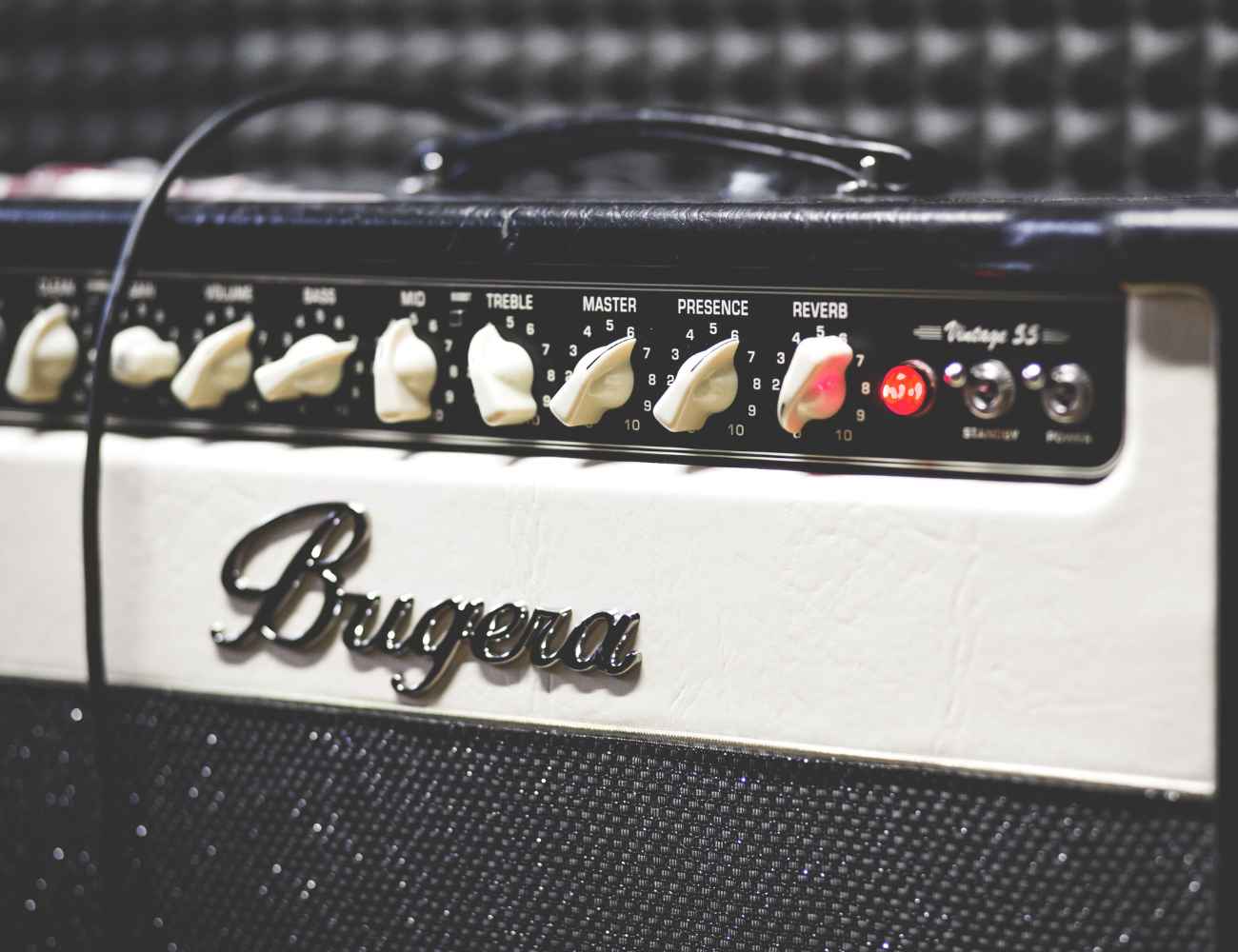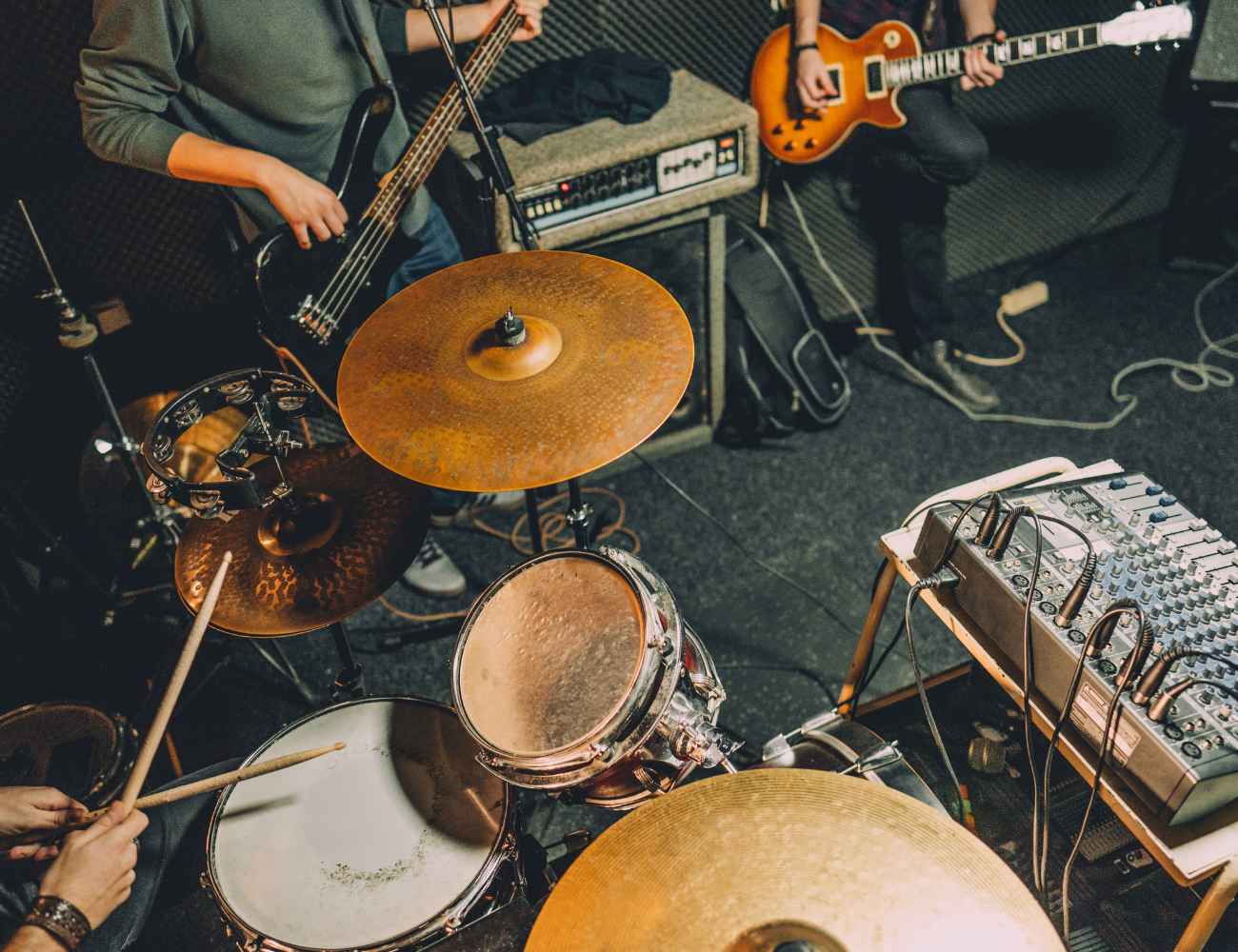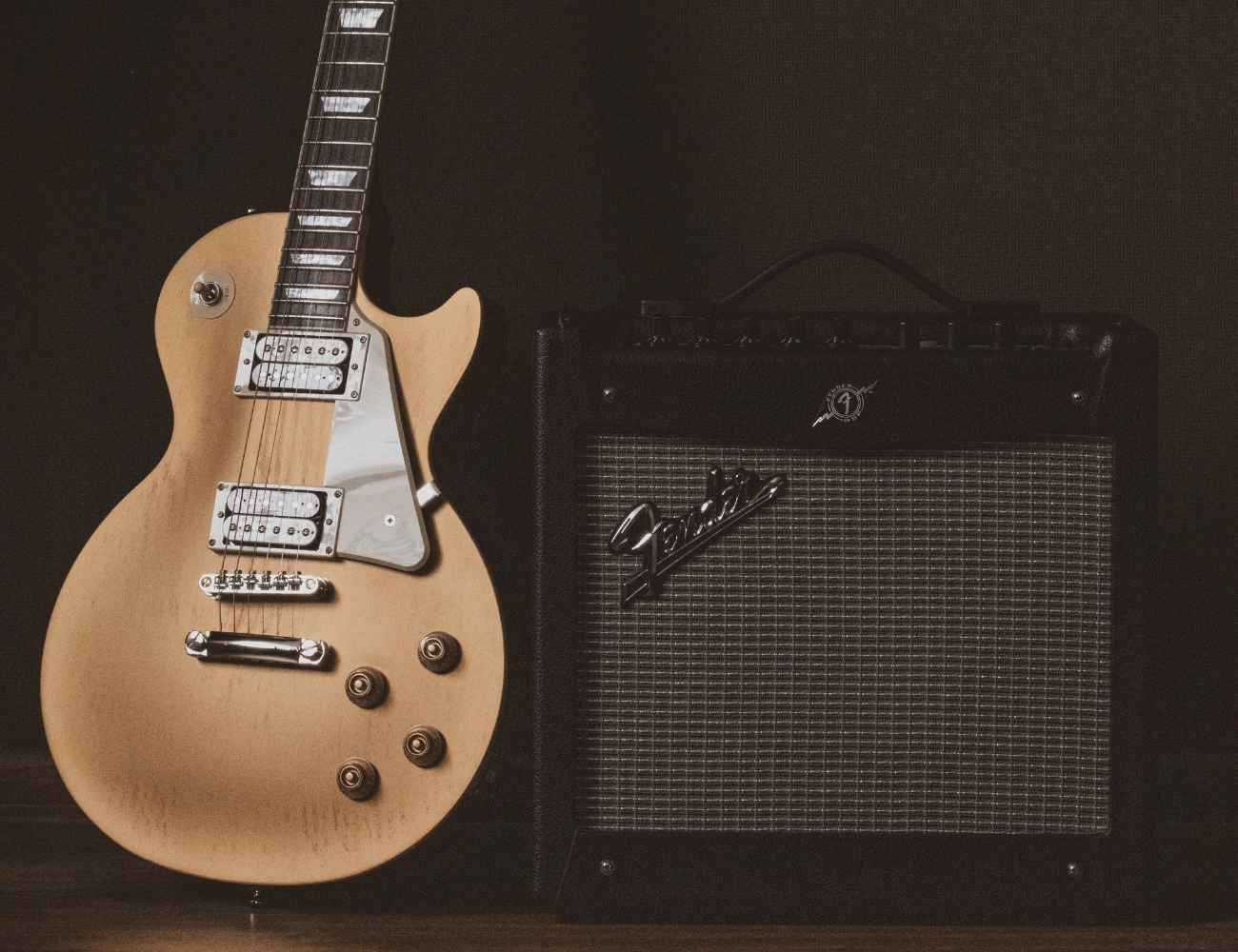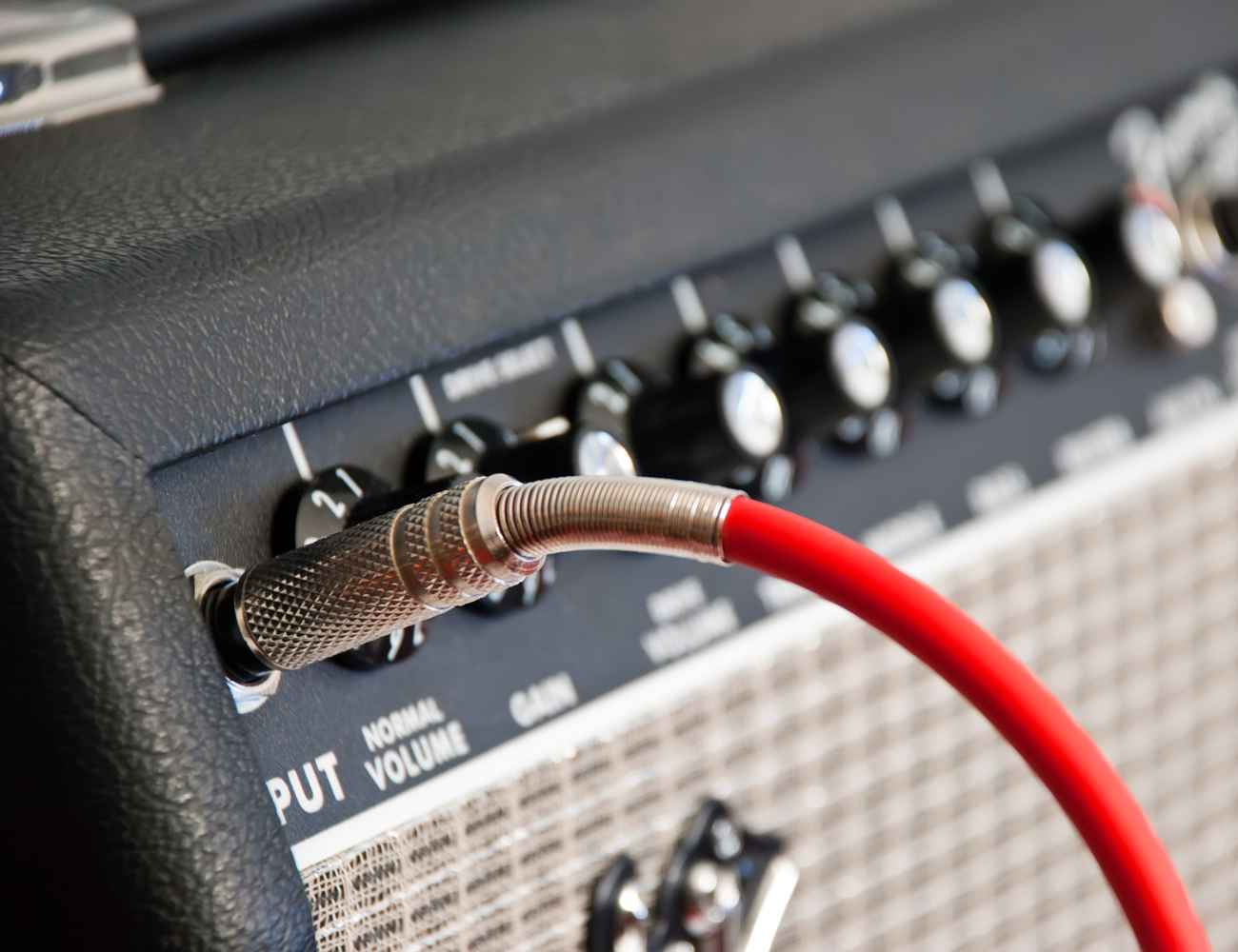Ever feel like you’re playing the guitar but see no progress in the way you sound?
You practice your jazz scales, perfect your technique, and can even play with some authority, but it just doesn’t sound right.
If you want to get that professional sound out of your instrument, one way to make it happen is by getting one of the best guitar jazz amplifiers.
These days there are an incredible variety of options on the market for amps for jazz guitar, but don’t fret!
We’ve tested and reviewed multiple different models from all price ranges, which we think give the best-in-class results for this style.
Table of Contents
- The Best Jazz Guitar Amplifiers
- Roland JC-120 Jazz Chorus Amplifier
- Fender 68 Custom Twin Reverb Amplifier
- Roland Cube Street Amplifier
- Fender Champion 40 Guitar Amplifier
- Fender George Benson Hot Rod Deluxe Amplifier
- AER COMPACT Amplifier
- Fender Blues Junior Lacquered Tweed Amplifier
- Roland JC-40 Jazz Chorus Amplifier
- Fender ’65 Princeton Reverb Amplifier
- Boss Katana MKII-100 Amplifier
- Peavey Classic 30 Amplifier
- Marshall DSL40CR-U Amplifier
- Vox AC30C2 Amplifier
- Orange Amps Crush 35RT Amplifier
- Roland CUBE-10GX Amplifier
- VOX AC15C1 Amplifier
- Supro 1612RT Amulet Amplifier
- What is a jazz guitar amplifier?
- What types of amplifiers are best for jazz guitar?
- How much should you expect to spend on a jazz guitar amplifier?
- Can you use a regular guitar amplifier for a jazz guitar?
- What are the key features to look for in a jazz guitar amplifier?
The Best Jazz Guitar Amplifiers
Roland JC-120 Jazz Chorus Amplifier
A 120W power, stereo effects loop, great value.
The Roland JC-120 Jazz Chorus solid state amp is an affordable, high-performance option that offers incredible sound quality and stereo sound capabilities. It features two input channels with their own three-band EQ, distortion/Reverb knobs and adjustable Chorus, Vibrato, and depth control cluster. It also has a 120 Watts of combined power, classic silver cone speakers, stereo effects loop, and footswitch.
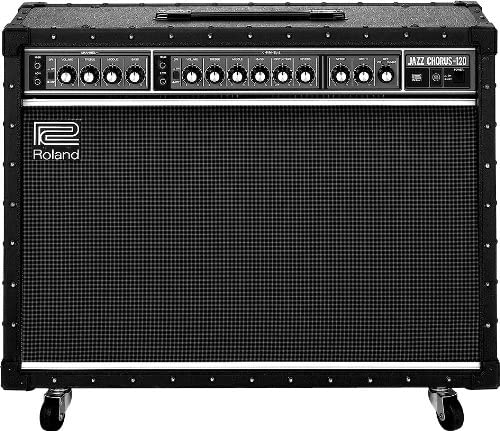
When you thought the best jazz guitar amplifiers were out of reach, Roland comes through with the JC-120 Jazz Chorus. This versatile stereo amp packs many features and can fit your budget – all while delivering incredible sound.
At first glance, you may need to be more impressed with its classic 80s/90’s design. But as far as controls go, it is surprisingly intuitive and tactile – making dialing in tones a breeze.
Two input channels each have their own three-band EQ, distortion/Reverb knobs, and an adjustable Chorus, Vibrato, and depth control cluster at the end. And those are just the basics!
The two power amps deliver an astonishing 120 Watts of combined power, enough to fill any room or performance space.
In addition, the classic silver cone speakers also provide unbeatable clarity and power handling for whatever type of sound you want to achieve. And if that wasn’t enough already, there’s also a stereo effects loop and footswitch for added convenience/flexibility.
The Roland JC-120 Jazz Chorus amp’s clean channel is considered one of the best in its class.
It provides a range of tonal options – from bluesy overdrive to smooth jazz chords – and even experienced musicians have praised the quality of sound it produces. The dual amplifier setup also gives it impeccable stereo sound, adding to its overall appeal.
And they had doubts about their existing pedals before plugging them in. In that case, they’ll quickly change their minds after testing Roland’s dual amplifier setup (which gives it impeccable stereo sound).
The Roland JC-120 Jazz Chorus solid state amp deserves well-earned recognition as one of the best amps under $1000 today.
Everything from its build quality to sound production is top-notch – combining affordability with top performance at every step.
With so many features packed into such a compact shell, it’s difficult not to be impressed by this equipment!
- Pros:
- Dual power amps.
- Intuitive controls.
- Stereo effects loop.
- Cons:
- None.
My final verdict is that the Roland JC-120 Jazz Chorus is an impressive amplifier packed with features and delivering incredible sound at an affordable price.
It has intuitive controls and produces a range of tones, and with dual amplifiers and effects loop, it is a great option for both experienced and beginner musicians.
Fender 68 Custom Twin Reverb Amplifier
Vintage sound, modern design, 85W of power.
The Fender ’68 Custom Twin Reverb offers 85 watts of power, hand-wired 6L6 power tubes, and two 12″ Celestion G12V-70 speakers for a classic jazz sound. It also features a modified Bassman tone stack, vintage track, and useful extras like a built-in kickstand and two-button footswitch.
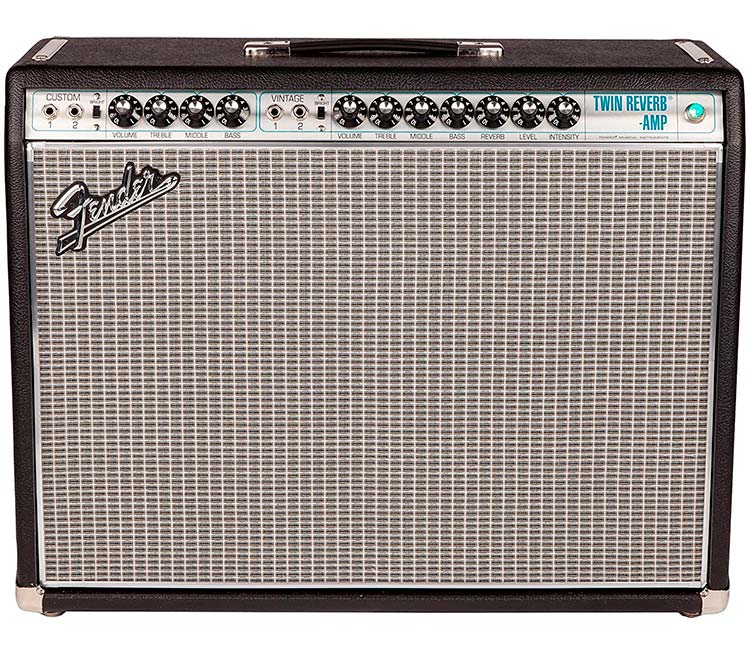
The Fender 68′ Custom Twin Reverb is one of the best jazz amplifiers available today, thanks to its outstanding design, build, and performance.
The amp’s design remains true to the classic ‘Silverface’ look of late 1960s Fender amps with a few modern touches.
An eye-catching turquoise-tinted front panel and silver-turquoise grille cloth provide this vintage vibe while still delivering an up-to-date look.
The ’68 Custom Twin Reverb’s internal components make this amp truly special. It’s packed with hand-wired 6L6 power tubes, six preamp tubes, vintage-spec Schumacher transformers, and two 12″ Celestion G12V-70 speakers to offer a massive 85 watts of power.
It also comes with useful extras like a built-in kickstand, two-button footswitch, and cover dust cover, making it ideal for live performances.
In terms of sound quality, the ’68 Custom Twin Reverb is unsurpassable. Its clean tones capture every nuance of your playing without breaking up quickly.
In addition, the custom channel provides a modified Bassman tone stack that takes pedals with ease, while the vintage track boasts a traditional warm tube tone, including great definition.
This high-quality amplifier has plenty of headroom for louder volumes making it especially popular among jazz guitarists who need their sound heard without compromising clarity or warmth.
With such excellent components and superb sound capabilities, this premium 85-watt amp will not disappoint – proving to be one of the best jazz amplifiers!
- Pros:
- Vintage design.
- Hand-wired tubes.
- Powerful sound.
- Cons:
- Expensive.
- Heavy.
My final verdict is that the Fender 68′ Custom Twin Reverb is an outstanding jazz amplifier, with its eye-catching design and vintage vibe combined with modern touches, hand-wired components and two 12″ Celestion G12V-70 speakers delivering 85 watts of power.
It also comes with useful extras like a built-in kickstand and two-button footswitch.
The sound quality is unsurpassable, with plenty of headroom for louder volumes, making it the perfect choice for jazz guitarists.
Overall, this is an excellent amp and an excellent value for money.
Roland Cube Street Amplifier
Portable, powerful features, great sound quality.
The Roland Cube Street is a portable and reliable jazz amplifier, offering 5 watts of power per channel, 8 COSM amp models, and 6 digital effects. With its aux input and AC/battery power sources, it can produce rich and varied tones, suitable for home practice, lessons, and more.

The Roland Cube Street is an excellent jazz amplifier in its price range due to its impressive features and performance.
This sub-$300 unit is designed for portability and convenience, making it ideal for home practice, lessons, street performances, or any other gigging situation.
It’s light but sturdy with a black case and silver grille, powered by two high-performance 6.5” neodymium speakers able to produce 5 watts of power per channel.
Performance-wise, this amp impresses with its COSM amp models offering eight different options, plus six digital effects, including chorus, flanger, delay, and tremolo.
The controls are also extensive yet easy to access on top of the amp – three EQ controls (bass, middle, and treble) and gain and volume knobs on the guitar channel.
In contrast, the mic channel includes two-band EQ (bass & treble), delay/reverb, and an output volume knob. Furthermore, there’s an auxiliary input for MP3s plus an AC adapter – which is excellent given that battery can also power it for up to 15 hours!
The sound quality produced from all these features is rich and varied, ranging from warm/jazz cleans to aggressive high-gain distortion tones that will suit rockers or metalheads alike.
It’s not the loudest amplifier in this price range but still enough for intimate settings like home practice or lessons.
In conclusion, if you’re looking for a reliably portable amp hat that packs plenty of powerful features without breaking the bank and pe, look no further than the Roland Cube Street solid state amp!
- Pros:
- High-performance speakers.
- COSM amp models.
- Extensive controls.
- Cons:
- Not loudest amp.
- Battery-powered.
My final verdict is that the Roland Cube Street is an excellent choice for anyone seeking a reliable and portable amplifier packed with powerful features and great sound quality at an affordable price.
Fender Champion 40 Guitar Amplifier
Versatile, great jazz tones, unbeatable value.
The Fender Champion 40 Combo is a great jazz amp, offering classic vintage design, two channels, and plenty of features. With its 12″ speaker and 40 Watts of power, it’s perfect for smaller venues and provides great sound quality. Its two channels and effects selection make it ideal for creating jazz tones quickly and easily.
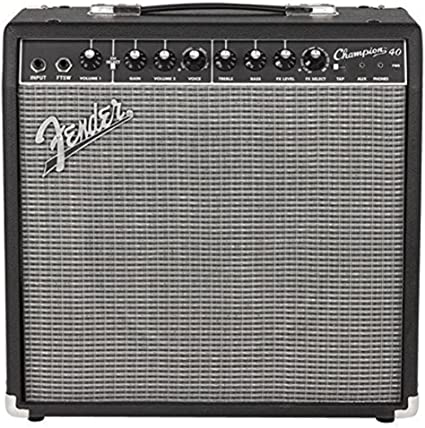
The Fender Champion 40 Combo is among the best amplifiers, especially in jazz. It has a classic vintage design and packs various features that make it incredibly versatile. In addition, at only $200, it provides exceptional value for money.
The controls are surprisingly accurate and straightforward – even if they are strangely arranged!
There’s a clean channel volume knob, gain, volume, and voice selection for the second channel and two-band EQ, FX level control, and FX selects knob. There’s also a channel fix button and tap tempo button.
Underneath its classic vintage design lies an impressive speaker at 12 inches, capable of delivering up to 40 Watts of power at any moment.
This makes it great for both practice and live performances in smaller venues. And with its two channels plus effects selection, you can create great jazz tones quickly and easily.
The famous Fender amp sound shines through, too – you may not get Twin Reverb quality, but you’ll be close!
Its clean channel provides plenty of definition and clarity, while its overdrive channel offers versatility between blues and rock tones. You can even push your heavier sounds further with extra ‘aces up its sleeve.’
The Fender Champion 40 Combo is a unique jazz amp that delivers incredible performance at fantastic value for money. There’s no doubt why this is one of the most popular choices out there!
- Pros:
- Classic vintage design.
- Versatile features.
- Value for money.
- Cons:
- Strange control layout.
- Limited power.
My final verdict is that the Fender Champion 40 Combo is an excellent choice for jazz guitarists.
It’s affordable, has great sound quality, and is versatile enough to cover blues and rock tones.
With its two channels and effects, it will allow you to quickly and easily create great jazz tones.
Fender George Benson Hot Rod Deluxe Amplifier
Legendary jazz tone and response in an iconic amp.
The Fender George Benson Hot Rod Deluxe is an amazing amp tailored to jazz guitarists with two 6L6 tubes, a 12″ Jensen C12K speaker, and a range of knobs for volume, bass, treble, and more. Its warm tones and spring reverb offer exceptional clarity and depth, making it a favorite of George Benson himself.
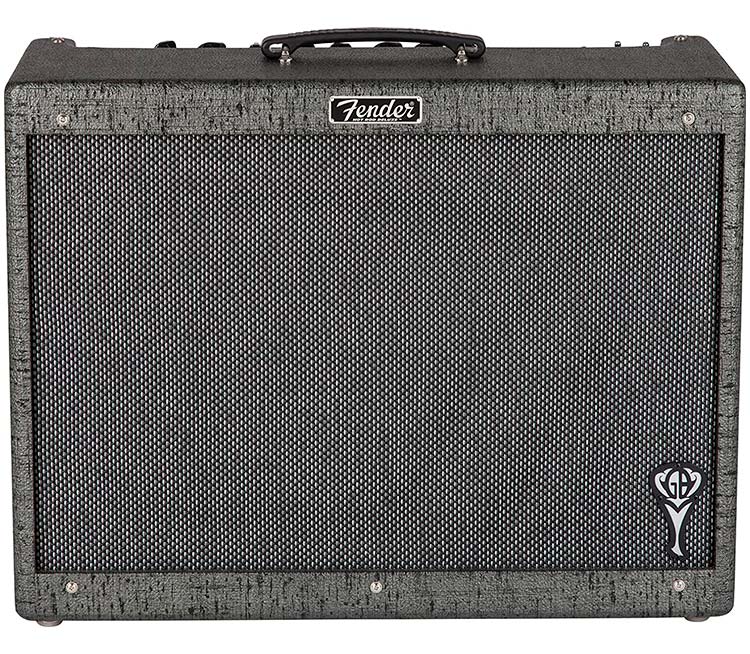
The Fender George Benson Hot Rod Deluxe is an exceptionally well-crafted, excellent-sounding amp tailored to jazz guitarists’ needs.
This amp oozes class from its stylish black, and grey flecked vinyl cover, silver grille, and signature GB logo to the high-quality solid pine cabinet beneath.
Under the hood, this 40-watt combo amp is powered by two 6L6 tubes and boasts a 12″ Jensen C12K speaker and a single 12AT7 all-tube preamp – providing plenty of headroom for many jazz players.
The controls are typical for a Hot Rod; there are two inputs and a range of rotary knobs for volume, bass, treble, middle, drive, and master, as well as reverb and presence settings.
There is also a channel selector switch, bright switch, and ‘more gain’ switch, so you can tweak your sound until it’s perfect.
The performance of this amp truly allows it to stand out among other models as it produces warm tones yet still retains clarity even at higher volumes without distorting – something vital to jazz players!
In addition, its spring reverb offers plenty of depth, while its two-button footswitch will come in handy on stage when going between channels or accessing different effects.
Simply put, the Fender George Benson Hot Rod Deluxe is one of the best amps available for anyone looking for exceptional tone and response from their instrument while playing jazz music – making it easy to see why it’s endorsed by one of the greatest guitarists in history: George Benson himself!
- Pros:
- Stylish design.
- High-quality sound.
- Versatile controls.
- Cons:
- None.
My final verdict is that the Fender George Benson Hot Rod Deluxe is an exceptional and well-crafted amp that offers excellent sound and a wide range of features tailored to jazz guitarists’ needs.
The amp produces warm tones with clarity at higher volumes and the spring reverb offers plenty of depth.
All in all, this amp stands out among other models and is a must-have for jazz guitarists.
AER COMPACT Amplifier
Powerful yet affordable jazz amp for ultimate clarity.
The AER Compact 60 rev.4 is a renowned 60-watt acoustic guitar amplifier with a Pre FX / Post FX switch and 3.5mm Aux input. It is renowned for its perfect reproduction accuracy, portability, and affordability, making it a favorite among professional jazz musicians.
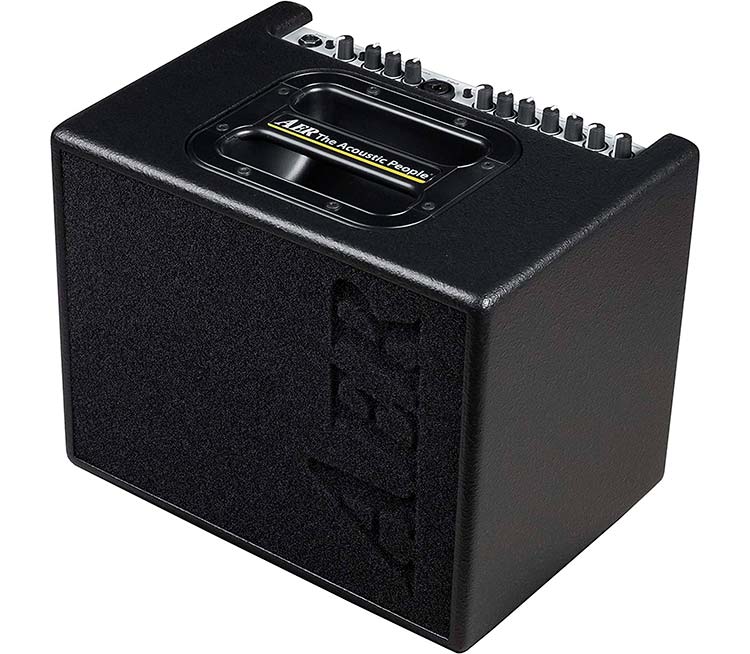
The AER Compact 60 rev.4 is one of the best amplifiers for jazz musicians, thanks to its robust twin-channel acoustic guitar amplifier design and carefully crafted electronics.
Made with piezoceramic pickups, microphones, and any line signal in mind, this amplifier offers a dynamically controlled 60 watts power amplifier that can produce a brilliantly clear sound.
Professional guitarists such as Robin Nolan, Angelo Debarre, Bireli Lagrene, Romane, Neil Anderson, Dorado Schmitt, and The Rosenberg Trio have relied on the AER Compact 60 rev.4 for many years now.
The amp has all the features necessary to provide maximum functionality while remaining simple. Its Pre FX / Post FX switch allows users to choose whether they want their Direct Out signal to incorporate the onboard digital effects.
A 3.5mm Aux input with Level control has also been added for further convenience and ease of use.
This ultra-portable amp is capable of exceptional reproduction of acoustic instruments and vocals – even at high volumes – without any distortion whatsoever.
A big part of why this amp stands out as one of the best jazz amplifiers is its noteworthy performance when paired with passive pickups (without controls for volume or equalizers).
After testing a guitar with nylon cords, it was discovered to produce an incredibly perfect sound that requires no modification; even better was the crystal clear sound produced after experimenting with two different Gibson and Taylor guitars!
It is evident that professionals rely on this amp for its minimal design – the combination of pickup settings and controls develops a unique sound that is hard to come by elsewhere.
The AER Compact 60 rev.4 sets itself apart from other acoustic guitar amplifiers due to its perfect reproduction accuracy, portability, and affordability.
With its remarkable power output and clarity, this small-sized amp remains one of the best options available for jazz musicians looking to give their music true shine!
- Pros:
- 60 watt power.
- Pre FX/Post FX.
- 3.5mm Aux input.
- Cons:
- No con found.
My final verdict is that the AER Compact 60 rev.4 is one of the best amplifiers for jazz musicians, with its robust twin-channel acoustic guitar amplifier design and carefully crafted electronics.
Its Pre FX / Post FX switch and 3.5mm Aux input with Level control provide users with maximum functionality and convenience.
Its noteworthy performance when paired with passive pickups and its crystal clear sound with different guitars make it an ideal choice for professionals, and its minimal design, portability and affordability make it a great value for any jazz musician looking to give their music true shine!
Fender Blues Junior Lacquered Tweed Amplifier
Warm tube tones, flexible controls, stylish and affordable.
The Fender Blues Junior Guitar Amplifier offers classic warm tube tones, a FAT switch for thicker tones and subtle overdrive, and a Jensen P12N speaker for excellent clarity and warmth. Its flexible controls and vintage style make it perfect for jazz guitarists looking for an affordable yet high-quality amp.
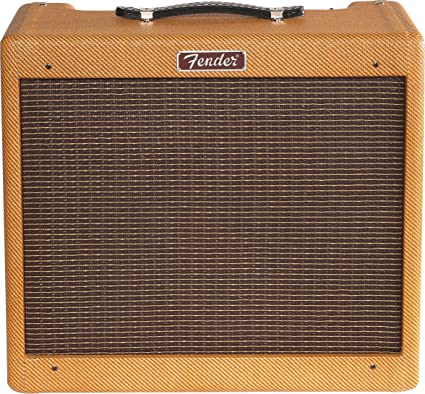
The Fender Blues Junior Guitar Amplifier, Lacquered Tweed, is one of the best jazz amplifiers for various reasons.
It has classic warm tube tones provided by the EL84 power tubes and 12ax7 pre-amp tubes, allowing it to replicate traditional jazz sounds easy.
Additionally, the foot-switchable “FAT” option adds thicker tones and subtle overdrive to help you create unique tonal qualities.
The onboard spring reverb provides a significant echo effect that can be used to add depth and texture to your playing. Furthermore, the lacquer tweed cabinet ensures years of durability and exceptional sound quality.
In addition, this amp has excellent clarity and warmth due to its Jensen P12N speaker. It’s also easy to dial in specific tones with its flexible controls.
For those looking for an extra kick, the FAT switch provides mid-boosting capabilities while maintaining control over your tone – making it ideal for jazz guitarists looking to cut through dense ensemble pieces.
And lastly, its beautiful chromed panel and tweed finish with vintage-style brown and gold grille cloth make it look as good as it sounds!
The Fender Blues Junior is perfect for those starting their jazz career or even a professional looking for an affordable yet high-quality amp option.
Whether you are playing acoustic or electric guitar, this amplifier will provide you with a warm, articulate tone many Jazz fans appreciate.
With adjustable output volume ranging from studio/bedroom settings to small venue gigs – no matter your needs – this amp can handle them all!
In addition, having optional pedals such as tube screamers or blues driver allow you to add punch or texture when needed.
Overall, the Fender Blues Junior is one of the best jazz amplifiers out there due to its combination of high-quality sound craftsmanship with style and affordability; thus making it immensely appealing aesthetically and sonically!
- Pros:
- EL84 and 12ax7 tubes.
- FAT switch for boost.
- Jensen P12N speaker.
- Cons:
- None.
My final verdict is that the Fender Blues Junior Guitar Amplifier, Lacquered Tweed, is an excellent choice for jazz guitarists looking for an affordable yet high-quality option.
It offers classic warm tube tones, adjustable output volume, mid-boosting capabilities, and reverb for added depth and texture.
It also has a beautiful chromed panel and tweed finish with vintage-style brown and gold grille cloth, making it look as good as it sounds.
With its combination of sound craftsmanship and style, this amp is an ideal choice for any jazz musician.
Roland JC-40 Jazz Chorus Amplifier
Portable amp with onboard chorus and stereo inputs.
The Roland JC-40 is a powerful and portable 40-watt amplifier with 2x 10″ speakers and built-in chorus effect. Stereo inputs and onboard effects provide versatility, while its low price point makes it an unbeatable option for amateur and professional jazz guitarists.
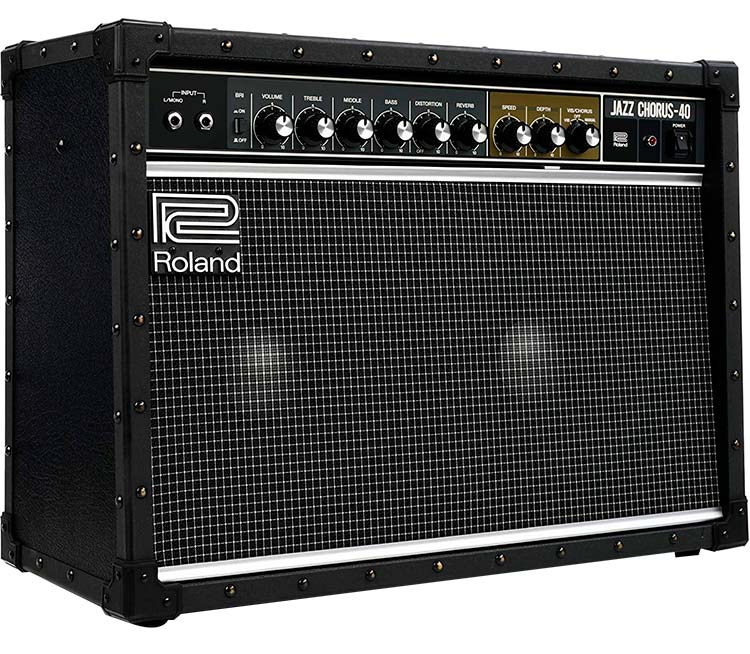
The Roland JC-40 is a go-to amplifier for jazz guitarists for its unparalleled sound quality.
Although the amp may be smaller than its predecessors, it certainly doesn’t lack power.
Boasting 40 watts of power and 2x 10″ speakers, the JC-40 is a versatile piece of equipment with various features that will take your music to the next level.
For starters, this solid state combo amplifier does not require any tubes or extra pieces due to its circuit board and speaker projects all being housed within one unit — making for easier transport and operation.
The JC-40’s stereo inputs also provide even more versatility when coupled with effects pedals and other sound devices, blending wonderfully without losing clarity.
But what sets this amp apart from the rest is its onboard effects capabilities — something that only a select few amps had access to when it was first released in 1975.
In addition, it made a name for itself by incorporating a chorus into its design — something rarely seen in stompbox pedals of the era — which quickly made it one of the most famous amps for jazz guitarists everywhere.
Its blend of portability and power makes this amp an unbeatable choice for anyone looking to up their playing level.
Aside from that, the low price point ($600) combined with input slots explicitly designed for stereos make it easy to get great sounds.
At the same time, its built-in chorus effect adds even more depth and variation to sound explorations – making this amp worth every penny!
This small but mighty amplifier truly has something for everyone; whether you are just starting out or a seasoned professional looking for premium sound quality at an accessible price point – you won’t be disappointed with what Roland has crafted with the JC-40!
- Pros:
- Portable & powerful.
- Stereo inputs.
- Built-in chorus.
- Cons:
- None.
My final verdict is that the Roland JC-40 is an unbeatable choice for any guitarist looking for great sound quality and versatility.
Its combination of portability, power, and effects capabilities make it both a great value and an incredibly versatile piece of equipment.
From beginners to professionals, the JC-40 offers something for everyone!
Fender ’65 Princeton Reverb Amplifier
Vintage cleans, warm overdrive, versatile sound.
Fender’s ’65 Princeton Reverb is an iconic amplifier offering 15 Watts of power and a versatile range of sounds. Its vacuum tubes, Jensen Special Design C-10R 10″ speaker, and Groove Tubes 6V6s provide a classic, clean tone while its two-band EQ and reverb controls give you more options for customizing your sound.
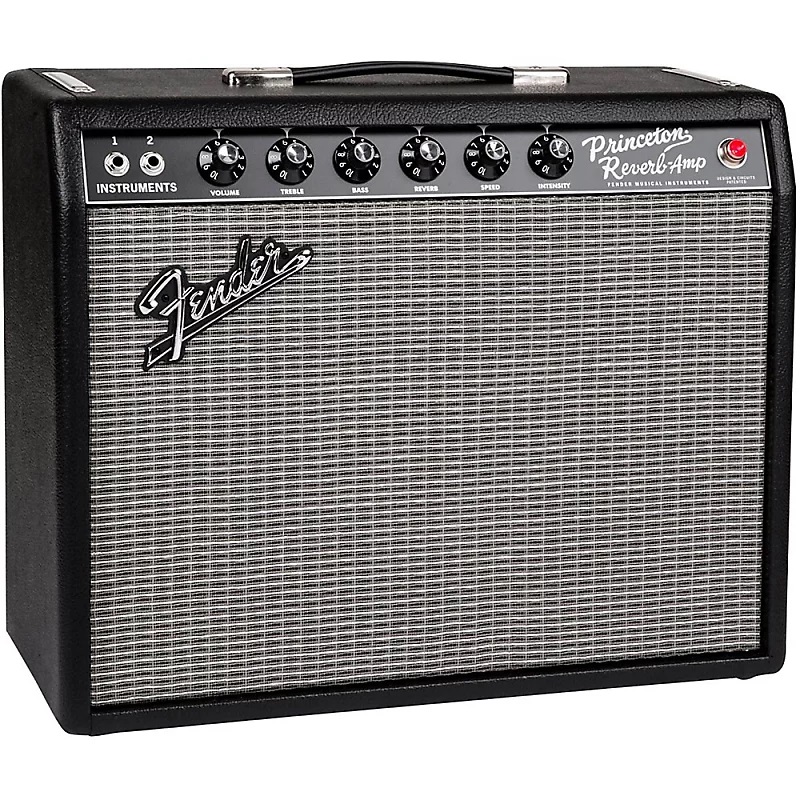
Fender’s ’65 Princeton Reverb amplifier is one of the most iconic combos ever to grace the world of jazz guitar amplifiers. It was designed as a remake of its original predecessor but with modern controls and features.
Every aspect was carefully considered, down to its complement of vacuum tubes, Jensen Special Design C-10R 10″ speaker, and Groove Tubes 6V6s.
On top of that, it packs 15 Watts at 8 Ohms of power output, offering an impressive level of sound quality.
This amp is renowned for producing one of the best vintage cleans imaginable – raw, unrefined, yet still clear and articulate. Adding a two-band EQ and reverb controls offers further versatility, so you can customize your sound however you want.
For those seeking more bite from their tone, this Princeton Reverb also boasts a warm natural overdrive setting that’ll give your riffs precisely what they need to cut through.
Whether you’re looking for recording studio quality or just something suitable for smaller gigs in local venues, Fender ’65 Princeton Reverb has got you covered.
Its simplicity makes it easy to use – it will take up to 30 minutes to get accustomed to the setup or make minor adjustments.
Plus, the amp pairs well with pedals, too, if you like using effects on your guitar solos or melodies.
Fender’s Princeton Reverb is among the best jazz guitar amplifiers today, owing to its immense versatility in styling and sound quality. It may not come cheap, but once you hear what it can do for your playing – you’ll agree it’s worth every penny!
- Pros:
- Versatile styling.
- High sound quality.
- Easily adjustable.
- Cons:
- Expensive.
- Time-consuming setup.
My final verdict is that Fender’s ’65 Princeton Reverb amplifier is an excellent choice for jazz guitarists, as it offers an impressive level of sound quality and is renowned for producing some of the best vintage cleans imaginable.
Its two-band EQ, reverb, and overdrive settings give ample versatility and the amp pairs well with pedals to add even more effects.
Although it may not come cheap, it is worth every penny for its quality and versatility.
Boss Katana MKII-100 Amplifier
Unbeatable combination of classic design and modern technology.
The Boss Katana MKII-100 is the perfect jazz amplifier for any musician seeking a versatile and powerful sound. With its five modeled amp variations, five independent effects sections, and stereo input slots, this amp provides endless tonal possibilities at an affordable price.
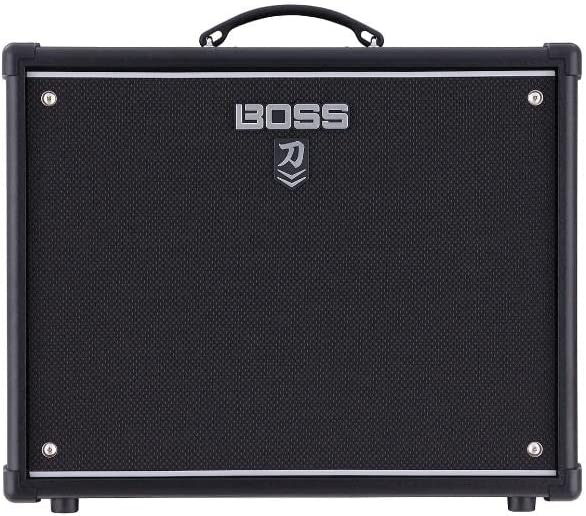
The Boss Katana MKII-100 is one of the best jazz amplifiers due to its incredible combination of modern technology, classic design, and exceptional versatility.
This 100-watt combo amplifier features a single 12″ speaker, variable power control for quieter moments, and five modeled amp variations, including clean, crunch, lead, brown, and acoustic.
In addition, it houses five independent effects sections, including booster, mod, FX, delays, and reverb.
Three modeled cabinet options in vintage, modern, and deep give users an even greater range of tonal possibilities.
Not only does the Katana MKII-100 provide users with an unbelievably wide variety of sounds from every corner of the jazz world, but it boasts some awe-inspiring technological capabilities.
Boss’s Tube Logic design approach helps boost power and character, while their Tone Studio software can be used with this device to customize any sound imaginable further.
The sheer number of tones available makes this amp incredibly attractive to those who want a versatile instrument to tweak to create their unique sound.
And with its modest price tag and high wattage output, it’s ideal for semi-professional players who need something that won’t break the bank but will still deliver premium sound quality.
In short, if you need to cover many tonal possibilities for your jazz guitar playing, look no further than the Boss Katana MKII-100.
An unbeatable combination of classic design and modern technology makes this one of the most powerful and versatile amplifiers today – perfect for any aspiring jazz guitarist looking for a fantastic performance without breaking their budget.
Its blend of portability and power makes this amp an unbeatable choice for anyone looking to up their playing level.
Its low price point ($600) combined with input slots explicitly designed for stereos make it easy to get great sounds.
At the same time, its built-in chorus effect adds even more depth and variation to sound explorations – making this amp worth every penny!
This small but mighty amplifier truly has something for everyone; whether you are just starting or a seasoned professional looking for premium sound quality at an accessible price point – you won’t be disappointed with what Boss has crafted with the Katana Mk II!
- Pros:
- Versatile tones.
- Tube Logic design.
- Accessible price.
- Cons:
- None.
My final verdict is that the Boss Katana MKII-100 is an incredible jazz amplifier and an unbeatable choice for any jazz guitarist, professional or beginner.
It offers an exceptional combination of modern technology, classic design, and versatility, making it suitable for any budget.
With its variable power control, modeled amp variations, independent effects sections, and modeled cabinet options, this amplifier allows users to create any sound imaginable.
Its low price point and high wattage output make this amp an ideal choice for semi-professional musicians who need a dependable and powerful amplifier.
Peavey Classic 30 Amplifier
Amp with classic tweed design and stellar sound.
The Peavey Classic 30 is a compact, powerful tube combo amp with seven tubes, 12AX7 and EL84, and a Celestion Midnight 60 speaker. It’s versatile enough to accommodate jazz, blues, rock, and even metal tones, and comes in a classic tweed design for a classic look and sound.

The Peavey Classic 30 is a highly versatile tube combo amplifier that packs a punch and is excellent value for money.
The impressive steel cage housing seven tubes – three 12AX7s and four EL84s – along with the 12″ Celestion Midnight 60 speaker gives it the power to deliver loud, stunning sound at no more than 30 watts.
The controls are easy to use and located on the top of the chrome-plated panel, offering volume control, pre, and post-gain controls for the lead channel, and reverb rotary, bass, middle, and treble controls.
There’s also a channel select switch, a boost switch, and an I/O jack for the effects loop. Overall, it’s a straightforward but powerful setup with plenty of options.
Its classic tweed design, smooth black vinyl, and silver grille cloth make it look as good onstage as in your home studio or practice space.
Unsurprisingly, the Classic 30 has become hugely popular among jazz guitarists seeking an organic warmth from their clean channels – yet there’s more to it than meets the eye.
Its range of tones covers everything from hard-hitting blues rock growls to bright surf rock tremolos – without compromising its clarity when balancing against other instruments such as drums or keyboards.
Even metal can be squeezed out of it if needs be – although true metalheads should look elsewhere for an amp that matches their heavy demands perfectly.
Ultimately this little powerhouse offers excellent value for money by successfully giving you access to multiple genres without breaking the bank.
Sure some amps may offer hardcore metal capabilities.
Still, few can compete with what this one delivers in terms of versatility while maintaining its reliability over time.
This speaks volumes about why it continues to be one of the best jazz guitar amplifiers available today.
- Pros:
- Versatile tones.
- Excellent value.
- Easy controls.
- Cons:
- None.
My final verdict is that the Peavey Classic 30 is an excellent value for money tube combo amplifier that packs a punch and offers a range of tones from hard-hitting blues rock to bright surf rock tremolos, as well as some metal tones.
Its classic tweed design and smooth black vinyl make it look great onstage and its reliable performance over time makes it one of the best jazz guitar amplifiers available today.
Marshall DSL40CR-U Amplifier
Powerful jazz amp with versatile features and great sound.
The Marshall M-DSL40CR-U is an ideal jazz guitar amplifier with gain and volume controls, dedicated resonance control, and two master volume controls. It includes Celestion V-type speakers, Softube emulated output, and 4 x ECC83 and 2 x EL34 valves for 40w of power.
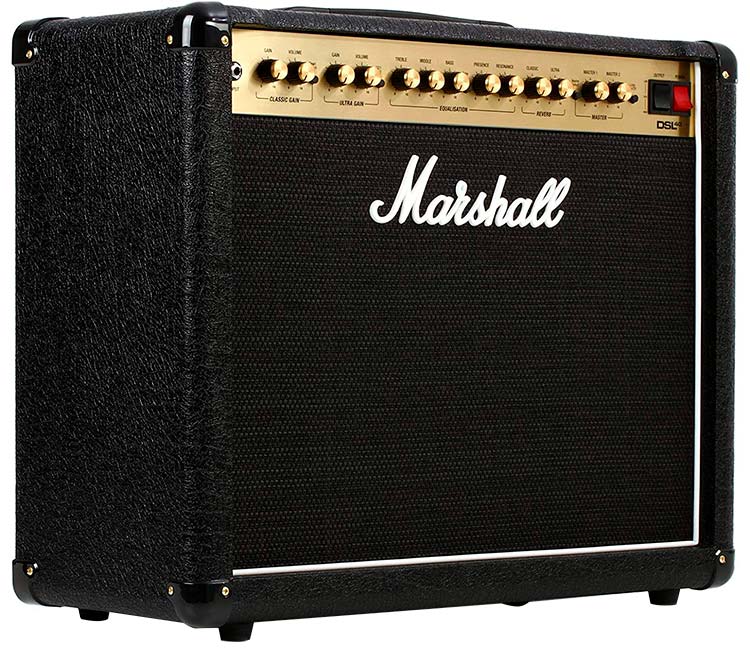
The Marshall M-DSL40CR-U is one of the best jazz guitar amplifiers out there. Its many features make it stand out among other amps, and its design makes it ideal for jazz.
First up, we have the gain and volume controls per channel. This allows you to customize your sound easily and get a deeper mix of jazz tones without worrying about too much distortion or fuzz.
On top of this, you have a dedicated resonance control and two master volume controls, which give you extra control over your sound.
The loudspeakers also play a vital role in the sound of this amp. The Celestion V-type speaker offers excellent clarity and warmth with plenty of depth, making it an ideal choice for jazz.
You also have Softube emulated output which further enhances the tone quality produced by this amp.
Finally, the valves are impressive – 4 x ECC83 and 2 x EL34, which provide 40w of power and can reduce that to 20w if necessary.
All these combined features make this an ideal setup for producing great jazz tones no matter your level in your playing journey.
Whether you’re just starting with jazz or an experienced player looking to upgrade your gear, the Marshall M-DSL40CR-U guitar combo amplifier is worth considering.
Its wide range of features and settings give it incredible versatility while maintaining a fantastic sound quality that is perfect for any style of music but particularly lends itself to producing unique jazz tones – from crystal clear cleans to complex overdriven sounds – all from one powerful unit!
- Pros:
- Customizable sound.
- Resonance control.
- Celestion speaker.
- Cons:
- None noted.
My final verdict is that the Marshall M-DSL40CR-U is an excellent jazz guitar amplifier, with great features and controls, a wonderful Celestion V-type speaker, and reliable valves that provide 40w of power.
Its versatility, customization options, and sound quality make it an ideal choice for both beginner and experienced jazz players, making it a great choice for anyone looking to upgrade their gear.
Vox AC30C2 Amplifier
Iconic sound, powerful technology, unbeatable value.
The AC30C2 is a legendary jazz guitar amplifier, offering classic British Invasion sound and powerful technology. Its iconic vintage design, sparkling cleans and natural overdrives, and two channels make it a popular choice for blues and classic rock players alike.
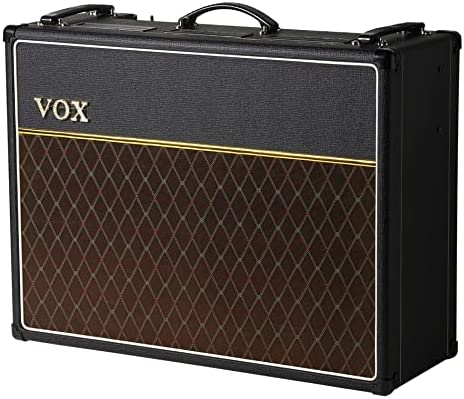
The AC30C2 is one of the best jazz guitar amplifiers in its price range. It’s a legendary amp used by some of the most iconic musicians worldwide, from The Beatles to Queen and Radiohead.
In addition, it is beloved for its classic British Invasion sound and impressive volume, making it perfect for any genre, from blues to rock.
The simple but effective controls provide an easy user experience, while the built-in reverb and tremolo effects add atmosphere.
Its design pays homage to the original vintage AC30 amps with features like the retro brown diamond grille cloth and burgundy top panel complete with chicken-head knobs.
Underneath all this style lies powerful technology with three 12AX7 preamp tubes and four EL84 power tubes, producing 30 watts of power through two 12″ Celestion G12M Greenback speakers.
The AC30C2 is renowned for its ability to recreate the timeless tones of 1960s British music repeatedly, yet it still retains a uniquely modern edge.
Players get sparkling cleans and natural overdrives that sing, delivering a genuine warmth under your fingertips.
Meanwhile, players can access two channels in one amp: one offering fat-rich tones and another more aggressive bark – making it ideal for both blues players and those seeking classic rock sounds.
Finally, at such a competitive midrange price point, having an amplifier with all this quality is unbeatable value for money – you’d be hard-pressed to find anything else quite like it!
- Pros:
- Powerful technology.
- Two channels.
- Classic sound.
- Cons:
- None.
My final verdict is that the AC30C2 is an excellent jazz guitar amplifier that is perfect for any genre of music.
It is renowned for its classic British Invasion sound, impressive volume, and ability to produce warm tones that echo the 1960s British music scene.
With powerful technology, two channels, and features like built-in reverb and tremolo effects, it is unbeatable value for money.
Orange Amps Crush 35RT Amplifier
Versatile, intuitive, great overdrive and price point.
Orange Amplifiers Crush 35RT is an affordable and versatile jazz amp, offering two-channel design, three-band EQ, reverb, tuner, and CabSim cluster. It has up to 35W of power, making it great for practice or gigging, and is less than $300.
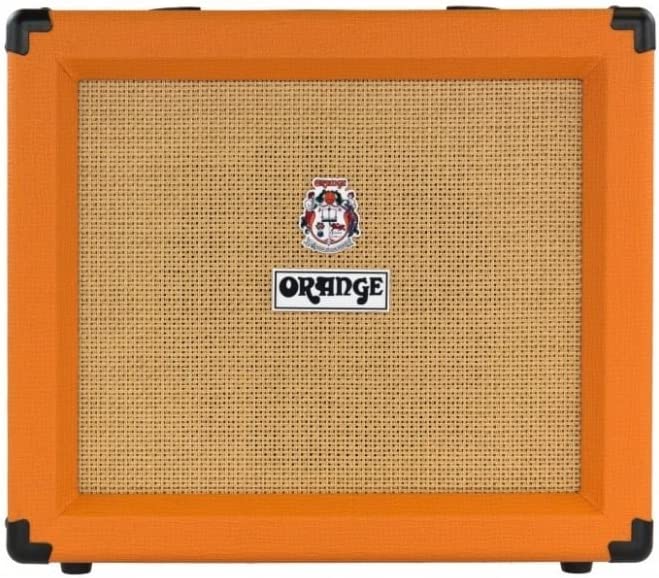
Orange amps are great for jazz amplifiers due to their exceptional overdrive capabilities, intuitive and easy-to-use controls, and versatile features.
To begin with, the Crush 35RT offers a two-channel design with a three-band EQ and reverb control.
In addition, the channels can be fine-tuned independently using knobs rather than buttons, making it much easier to adjust according to preference.
The amp also features an onboard tuner and CabSim cluster, replicating the sound of a 4×12-inch cabinet with just 10 inches of power pushing through it.
This allows musicians to get that classic stack tone without investing in more expensive equipment.
Additionally, the 35W of power makes it suitable as both a practice and gigging amplifier – making it perfect for any jazz gig or practice session.
Lastly, one of the most significant advantages of this amp is its price point which is less than $300–this makes it very competitive compared to other amps in the same range.
Furthermore, if we were missing one thing, it would be the speaker line out.
Still, this feature can easily be overlooked at such a great price point in favor of all the other offerings that make this amp great for jazz performances or recordings.
- Pros:
- 2-channel design.
- Easy-to-use knobs.
- Onboard tuner.
- Cons:
- No speaker line out.
- Low wattage.
My final verdict is that the Orange Amplifiers Crush 35RT is an excellent choice for jazz players looking for a great practice amp or studio recording rig.
It offers intuitive and easy-to-use controls, versatile features, two-channel design, three-band EQ, reverb control, onboard tuner and CabSim cluster, and 35W of power at an affordable price point.
Therefore, it is a great investment for any jazz performance or recording.
Roland CUBE-10GX Amplifier
Compact, custom tones, great value for jazz players.
The Roland CUBE-10GX is a great choice for jazz guitarists, featuring 10-watt amp with custom-designed 8″ speaker and COSM amps for sound quality. It has three onboard effects, multiple output jacks, and the CUBE KIT app for customizing tones.
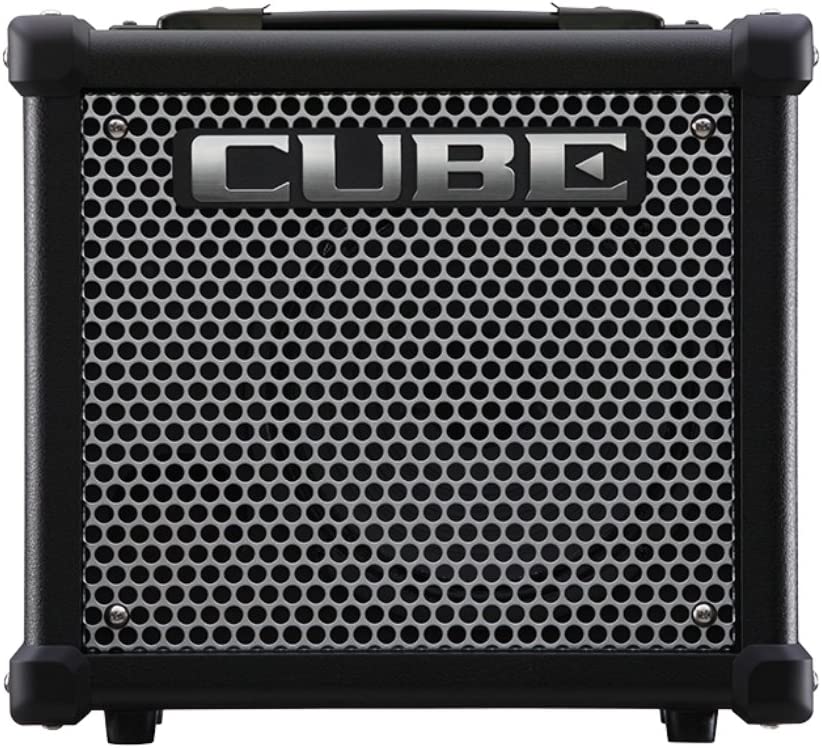
The Roland CUBE-10GX is an excellent option for jazz guitarists who want to take their playing to the next level.
Its compact size allows it to fit easily in small spaces, and its 10-watt amp with custom-designed 8″ speaker gives plenty of punch.
In addition, the COSM amps are designed for superior sound quality, allowing you to create your custom sounds simply and easily. Using the free CUBE KIT app on iOS and Android, you can even replace preset amps with custom ones.
The three onboard effects – chorus, delay, and reverb – allow you to create numerous soundscapes that can be finely tuned using the Bass, Middle, and Treble tone controls.
Plus, it has multiple output jacks, so you can use headphones or other devices without worrying about volume levels or feedback.
I’ve been using this amp myself recently, and I must admit that I’m impressed with its capabilities.
While at first, I found the audio quality uninspired compared to more expensive models, it does produce a good tone when cranked up all the way – perfect for recreating classic jazz styles.
I also appreciate that it’s quiet enough for practice sessions and studio recordings, so you don’t have to worry about any unwanted noise bleeding from other instruments or equipment.
Finally, while the initial cost may seem like a small investment, this amp still offers excellent value as it stands up well against much pricier amplifiers regarding sound and builds quality.
Furthermore, with its impressive range of features and tones available via the app, jazz players of all skill levels will find something they love about the Roland CUBE-10GX amplifier – making it an ideal choice for anyone looking for a great-sounding amp for their jazz playing needs!
- Pros:
- Compact size.
- High sound quality.
- Multiple outputs.
- Cons:
- None for the most part.
My final verdict is that the Roland CUBE-10GX amplifier is an excellent choice for jazz guitarists, offering great sound quality and a range of features that make it worth the investment.
It’s perfect for both practice sessions and studio recordings, and with the CUBE KIT app, jazz players of all skill levels can find something to love about this amp.
VOX AC15C1 Amplifier
Vintage design, modern convenience.
The Vox AC15C1 is an excellent amp for jazz guitarists, offering a 10” Celestion Greenback speaker, two channels, and switchable 8/16 ohm output. Its vintage design and modern features provide a classic feel and versatility for creative soundscapes.
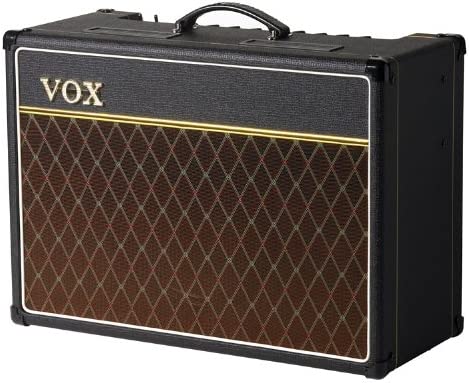
The Vox AC15C1 is an excellent choice for a jazz guitarist looking to achieve those clean chimney tones of the past. With its 10” Celestion Greenback speaker, the amp offers a mellower mid-range response than other amps on the market.
It has three 12AX7 preamp tubes and two EL84 power amp tubes, with a built-in tremolo and reverb. Additionally, it features two channels –a standard and a top boost channel– with individual channel volumes and master volumes.
The main difference between this model and many others is its ability to switch between 8 and 16 ohms when using an external speaker input.
This blend of old sound technology with modern convenience makes the AC15C1 stand out among other amplifiers.
Several prominent guitarists such as The Edge, Brian May, and John Scofield have also used it throughout their careers – so you know it must be exceptional!
The AC15 produced beautiful sounds at both loud and bedroom levels when playing live in a room or recording for practice.
Its two channels give players more options when creating their signature sounds instead of forcing them into one specific sound type, as some amps do.
Furthermore, one can get that classic “Vox shimmer” without taking away from their sound at all.
Overall, I highly recommend the Vox AC15C1 for any jazz guitarist looking for a dependable amplifier that will produce excellent sound variety while maintaining the classic feel they aim for.
Its combination of vintage design and modern conveniences makes it an ideal choice if you want to get creative with your music while still achieving those traditional tones we all love so much.
- Pros:
- Vintage design.
- Modern conveniences.
- Two channels.
- Cons:
- None.
My final verdict is that the Vox AC15C1 is an excellent choice for jazz guitarists looking for a dependable and versatile amplifier with classic tones.
It offers multiple channels, volume controls, and an 8/16 ohm switch, making it an ideal choice for creating unique sounds while still achieving the classic tone.
Additionally, its build quality and sound quality are both well-regarded, making it an excellent choice for professional musicians as well.
Supro 1612RT Amulet Amplifier
Versatile tube-driven jazz amp with dynamic tones.
Jazz guitar amplifiers offer dynamic range, high headroom, and range of controls for warm, clean tones. Their tube, solid state, and hybrid variations cater to different preferences and playing styles, making them essential for capturing the nuances of jazz guitar.
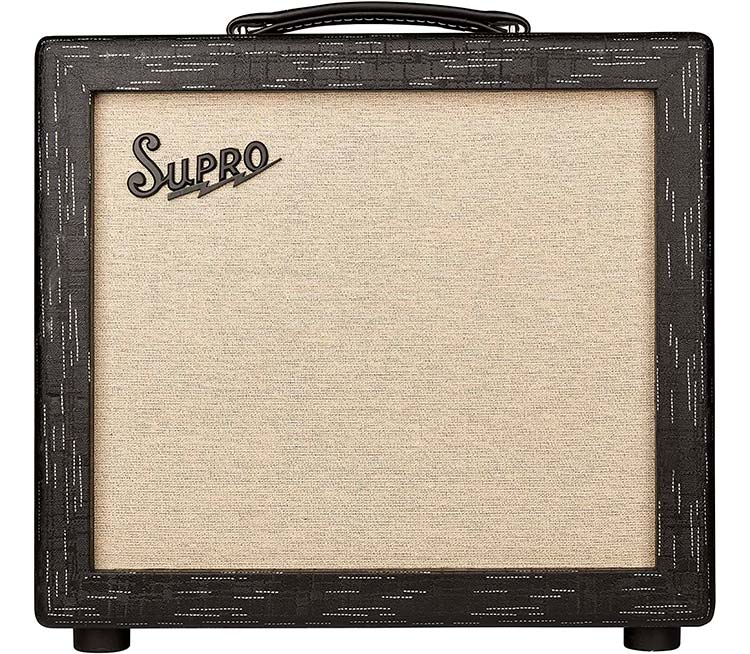
The Supro 1612RT Amulet 1 x 10-inch 15-Watt Tube Combo Amp is an innovative and feature-packed amp designed to bring vintage tone, flexibility, and power to musicians of all genres.
This combo amp packs a 6L6GC tube-driven Class A output for maximum clarity and rich harmonics. In addition, its compact size and lightweight construction make transporting or fitting into tight spaces easy.
The control panel includes Volume, Treble, Bass, Reverb, Tremolo Speed, and Depth knobs, plus a 3-position Output Power switch.
With this configuration, you can dial in the perfect sound, from clean to crunchy, without overpowering the house or studio band.
The Supro Amulet is also pretty cool looking! It’s housed in a 17.5″ x 17″ x 8″ poplar cabinet with a stylish black Scandia vinyl cover and cream grille cloth!
A large leatherette handle makes it super comfortable to carry around too.
A Celestion G10 Creamback speaker is rated at 45 watts to round off the package.
This amplifier shines when playing jazz music!
The class A output stage offers many overtones, second-order harmonics, and plenty of compressions, even at lower volumes, which helps retain dynamics without sacrificing the classic jazz tone.
You get full-on chewy vintage tones at higher volumes with an excellent grind for an expressive solo experience.
And if you want more out of it, there’s plenty of headroom left to push your drive pedals into overdrive heaven!
The combination of features narrows the gap between a Champ and a Princeton Reverb.
Still, it offers more versatility due to its built-in attenuator, allowing you to crank down power levels while retaining those big vintage sounds usually associated with high-wattage amps at louder volumes – making this amp great for smaller gigs or recordings where volume restrictions are in place.
However, you still want that great tube amp sound!
Overall, the Supro 1612RT Amulet 1×10 15-Watt Tube Combo Amp is an excellent choice for musicians who crave an incredibly versatile low-wattage tube-driven amplifier!
Which jazz amp should you choose? How do you know which one is best for me? If you are interested in knowing the answers to these questions, we recommend you watch this short video:
A jazz guitar amplifier is a specialized type designed to produce the warm, clean tones required for jazz music.
Jazz guitar is a unique style that heavily emphasizes intricate melodies, chord progressions, and improvisation and requires an amplifier that can reproduce the nuances of the instrument’s sound accurately.
In addition, these amplifiers highlight the guitar’s natural tones while minimizing distortion and other unwanted effects.
One of the essential features of a jazz guitar amplifier is its ability to produce a wide range of dynamic tones. Jazz music is known for its emotional range, requiring an amplifier that can handle soft, delicate, and loud, powerful sounds.
Jazz guitar amplifiers are designed to produce precise, clean tones at high volumes without distorting or breaking up.
Another critical feature of jazz guitar amplifiers is their high headroom. Headroom refers to the amount of power an amplifier can produce before it starts to distort or clip.
Jazz guitarists need amplifiers with high headroom because they often play with a lot of dynamics and must be able to produce loud, clear tones without distortion.
Jazz guitar amplifiers also typically feature a range of controls and settings that allow guitarists to shape their tone. These controls may include EQ settings for adjusting the bass, midrange, and treble frequencies, as well as reverb, delay, and other effects.
In addition, some amplifiers may consist of multiple channels, allowing guitarists to switch between different tones and settings on the fly.
Several different jazz guitar amplifiers are available, each with unique characteristics. For example, jazz guitarists often favor tube amplifiers for their warm, organic sound, while solid state amplifiers are known for their reliability and clean, transparent tone.
Finally, hybrid amplifiers combine the best of both worlds, offering the warmth and character of tube amps with the reliability and durability of solid state amps.
In conclusion, a jazz guitar amplifier is designed to produce the warm, clean tones required for jazz music. These amplifiers are characterized by their high headroom, dynamic range, and range of controls and settings.
In addition, they come in various types to suit different playing styles and preferences. Whether you’re a professional jazz guitarist or a hobbyist, a high-quality jazz guitar amplifier is essential for producing a jazz guitar’s authentic, nuanced sound.
- Pros:
- Compact size.
- Variety of controls.
- Classic jazz tone.
- Cons:
- No multiple channels.
My final verdict is that the Supro 1612RT Amulet 1×10 15-Watt Tube Combo Amp is an excellent choice for jazz musicians who are looking for a versatile and low-wattage tube-driven amplifier that provides full-on chewy vintage tones at higher volumes with an excellent grind for an expressive solo experience.
A jazz guitar amplifier is a specialized type designed to produce the warm, clean tones required for jazz music.
What is a jazz guitar amplifier?
Jazz guitar is a unique style that heavily emphasizes intricate melodies, chord progressions, and improvisation and requires an amplifier that can reproduce the nuances of the instrument’s sound accurately.
In addition, these amplifiers highlight the guitar’s natural tones while minimizing distortion and other unwanted effects.
One of the essential features of a jazz guitar amplifier is its ability to produce a wide range of dynamic tones.
Jazz music is known for its emotional range, requiring an amplifier that can handle soft, delicate, and loud, powerful sounds.
Said amplifiers are designed to produce precise, clean tones at high volumes without distorting or breaking up.
Another critical feature of jazz guitar amplifiers is their high headroom.
Headroom refers to the amount of power an amplifier can produce before it starts to distort or clip.
Jazz guitarists need amplifiers with high headroom because they often play with a lot of dynamics and must be able to produce loud, clear tones without distortion.
Most of these amplifiers also typically feature a range of controls and settings that allow guitarists to shape their tone.
These controls may include EQ settings for adjusting the bass, midrange, and treble frequencies, as well as reverb, delay, and other effects.
In addition, some amplifiers may consist of multiple channels, allowing guitarists to switch between different tones and settings on the fly.
Several different jazz guitar amplifiers are available, each with unique characteristics.
For example, jazz guitarists often favor tube amplifiers for their warm, organic sound, while solid state amplifiers are known for their reliability and clean, transparent tone.
Hybrid amplifiers combine the best of both worlds, offering the warmth and character of tube amps with the reliability and durability of solid state amps.
What types of amplifiers are best for jazz guitar?
When choosing the best amplifier for jazz guitar, there are several factors to consider, including the type of amplifier, its features, and the tone it produces.
Various amplifiers are suitable for a jazz guitar, each have and come with strengths and weaknesses.
– Tube Amplifiers
Tube amplifiers are widely regarded as the gold standard for jazz guitar amplification.

Jazz guitarists favor them for their warm, rich sound and for how they respond to the player’s touch and dynamics.
Tube amplifiers use vacuum tubes to amplify the guitar signal, which can produce a natural, organic tone with harmonic overtones that add depth and complexity to the sound.
However, tube amps are often heavy and expensive and require regular maintenance to keep them running smoothly.
– Solid State Amplifiers
Solid state amplifiers are popular for jazz guitarists who value reliability and durability when it comes to their gear.

They use transistors instead of vacuum tubes to amplify the signal, producing a clean, transparent tone well-suited for jazz music.
Said type of amps are also generally lighter, more affordable than tube amps, and require less maintenance.
Ang this is exactly what makes them a lot more valuable for a lot of guitarits on a budget, or simply those who value these features.
However, some players feel that solid state amps need more warmth and character than tube amps and can sound harsh or sterile.
Even though this can be compesated later by using pedals, that’s what people usually notice about these amps.
– Hybrid Amplifiers
Hybrid amplifiers have gained popularity among musicians as they successfully merge the distinctive qualities of both tube and solid-state amps, providing a versatile and practical solution for various playing styles.
These amplifiers employ vacuum tubes in the preamp section to create the warmth and character that tube amps are renowned for, while utilizing transistors in the power amp section for increased reliability and durability.
One of the significant advantages of hybrid amplifiers is their ability to produce a broad spectrum of tones.
Ranging from the warm, organic, and harmonically rich sounds that tube amps are famous for, to the clean, transparent, and precise tones that solid-state amps deliver.
This versatility makes hybrid amps suitable for a wide array of musical genres, including of course jazz, but also blues, rock, and more.
– Modeling Amplifiers
Modeling amplifiers use digital signal processing (DSP) technology to emulate the sounds and characteristics of various classic and modern amplifiers.
They provide a wide range of tonal options, making them highly versatile for guitarists of different genres.
These amps often come with built-in effects, allowing users to further shape and customize their sound.
On the other hand, modeling amplifiers are generally more lightweight and low-maintenance compared to their tube and solid-state counterparts.
They are a popular choice for musicians who require a wide array of tones and effects within a single, portable unit.
How much should you expect to spend on a jazz guitar amplifier?
The cost of a jazz guitar amplifier can vary widely depending on several factors, including the type of amplifier, its features, and the brand.
Many high-quality amplifiers are available at various price points, so it’s possible to find a good jazz guitar amplifier that fits your budget.
Tube amplifiers are often more expensive than solid state or hybrid amplifiers due to the vacuum tubes’ cost and the circuitry’s complexity.
High-end tube amplifiers from brands like Fender, Vox, and Mesa/Boogie can cost thousands of dollars.
Solid state amplifiers are generally less expensive than tube amps due to their simpler circuitry and use of transistors instead of vacuum tubes.
A few high-end solid state amps from brands like Roland, Boss, and Quilter can still cost several hundred dollars.
As a result, prices for solid state amplifiers can range from around $100 to several thousand dollars, depending on the model and brand.
Hybrid amplifiers are often priced somewhere between tube and solid state amps due to the vacuum tubes’ cost and the circuitry’s complexity.
Modeling amplifiers are generally the most affordable option for jazz guitarists, with many models available for less than $500.
The amount you should expect to spend on a jazz guitar amplifier depends on your budget and specific needs as a player.
A good jazz guitar amplifier should produce clear, clean tones with a wide dynamic range and enough headroom to handle the demands of jazz music.
It should also offer a range of controls and settings that allow you to shape your tone to your liking.
In case you opt for a high-end tube amp or a more affordable solid state or hybrid amp, finding an amplifier that sounds great to you and suits your playing style is most important.
Can you use a regular guitar amplifier for a jazz guitar?
While it’s possible to use a regular guitar amplifier for jazz guitar, there may be better options for those who truly care about tone.
Jazz guitar requires a clean, clear tone with a wide dynamic range and plenty of headroom to handle the dynamics of the music.
Regular guitar amplifiers, particularly those designed for rock or metal music, may not be optimized for this type of sound.
Most regular guitar amplifiers make distorted or overdriven tones, which can be great for rock, blues, or heavy metal but may not be suitable for jazz guitar.
In addition, these amps often have high-gain preamp stages, which can introduce unwanted distortion and compression into the signal.
They may also have smaller speakers, which can limit the amplifier’s frequency response and dynamic range.
In contrast, jazz guitar amplifiers produce clean, transparent tones, allowing the guitar’s natural sound to come through.
They typically have low-gain preamp stages, which minimize distortion and compression, and more prominent speakers, which allow for broader frequency response and more fantastic dynamic range.
Some jazz guitar amplifiers have built-in reverb or other effects commonly used in jazz music.
But, let’s say you still found another amp that’s not neccesarily built for jazz, how do you optimize it for the genre?
First, try to use the cleanest channel on the amplifier, and avoid using any distortion or overdrive pedals since this will help minimize the distortion and compression in the signal.
After that, I wouldmaybe even consider using a high-quality speaker cabinet optimized for jazz guitar.
This can help improve the amplifier’s frequency response and dynamic range; investing in a dedicated jazz guitar amplifier is worth it if you are serious about playing jazz guitar.
Even then, if you don’t want to get an extra cabinet, I would stick to making the signal as clean as possible, to achieve that classic jazzy tone.
What are the key features to look for in a jazz guitar amplifier?
Choosing a suitable amplifier is crucial for any guitarist, and this is particularly true for jazz guitarists.
Jazz guitar requires a clean, transparent tone with a wide dynamic range, and an optimized amplifier for this style of music can make a significant difference in the sound you can achieve.
Here are some key features to look for when choosing a jazz guitar amplifier:
– Clean channel
The most important feature to look for in a jazz guitar amplifier is a clean channel.
This is the channel that produces a pure, undistorted tone that allows the guitar’s natural sound to come through.
A clean channel is essential for jazz guitar because it provides a clear, transparent sound free from unwanted distortion or compression.
As such, this allows the nuances of your playing to come through and makes it easier to achieve a wide dynamic range.
The clean channel is usually the starting point for most jazz guitarists, as it is the foundation of the sound.
After than, you can then add different effects or pedals to create the desired sound for each song or performance.
– Headroom
Headroom refers to the amount of power an amplifier has before it starts to distort.
For jazz guitar, it’s crucial to have an amplifier with plenty of headroom, as this allows you to play louder without introducing distortion into the signal.
This is particularly important if you play in a band setting, where you may need to compete with other instruments that produce a lot of volumes.
Most jazz guitarists prefer a clean, clear tone, so having headroom is crucial to achieving this sound.
Without enough headroom, the amplifier will start to distort and produce a different sound than you intended, which will tend to sound very different from what you’d want in this case.
– Power
The power of an amplifier is measured in watts, and it refers to the amount of electrical power the amplifier can produce.
You don’t necessarily need a lot of energy for jazz guitar, but it’s essential to have enough to fill the room you are playing in.
A 15-30 watt amplifier is usually sufficient for small to medium-sized venues, while a 50-100 watt amplifier may be necessary for larger venues.
Keep in mind that having too much power can be a disadvantage as well.
For example, a high-wattage amplifier may be too loud for smaller venues or home use, and it may be more challenging to achieve a clean tone at lower volumes.
– Speaker size
More prominent speakers generally produce a fuller, more rounded sound, while smaller speakers produce a more focused sound.
For jazz guitar, it’s a good idea to choose an amplifier with at least a 10-inch speaker, as this will provide a good balance between clarity and warmth.
Some jazz guitar amplifiers use 12-inch speakers, which can provide even more warmth and depth to the sound.
Another vital factor to consider is the number of speakers that it comes with.
One single-speaker amplifier may be sufficient for smaller venues or home use, while a multiple-speaker amplifier may be necessary for larger venues.
– Reverb
Reverb is a common effect used in jazz guitar, and many jazz guitar amplifiers have built-in reverb circuits.
This characteristic adds a sense of space and depth to the sound, which can help create a more immersive playing experience.
When choosing an amplifier with a reverb, looking for a unit that produces a natural, organic-sounding reverb that complements the guitar’s sound is essential.
Different amplifiers may have different types of reverb, such as spring, hall, or plate, each with its unique sound.
Some amplifiers may also have adjustable reverb controls, which allow you to dial in the exact amount of reverb you want when playing.
– EQ controls
EQ controls allow you to adjust the amount of bass, midrange, and treble in the signal, which can help shape the amplifier’s sound to match your playing style or the requirements of a particular performance.
Jazz guitarists often prefer amplifiers with simple, intuitive EQ controls that allow them to dial in the desired tone quickly.
Some amplifiers have separate tone controls for each channel, while others have a shared tone control.
It’s important to note that EQ controls can significantly impact the sound of an amplifier, so it’s worth taking the time to experiment with different settings to find the tone that works best for your playing style.
– Effects loops
Effects loops allow you to insert effects pedals or processors into the signal chain of the amplifier.
This can be helpful for jazz guitarists who use a variety of effects, such as chorus, delay, or overdrive, to create their desired sound.
An effects loop typically consists of two jacks on the back of the amplifier, labeled “send” and “return.”
You connect your effects pedal or processor to the send and return jacks, sending the signal from the amplifier to the effect and back to the amplifier.
An effects loop can be a helpful feature for jazz guitarists, as it allows them to add effects to their signal chain without compromising the integrity of the clean tone.
– Size and portability
The size and portability of an amplifier can be an important consideration for jazz guitarists, particularly those who frequently perform live.
A large, heavy amplifier may be challenging to transport, while a smaller, more portable amplifier may be more practical for gigs.
Some jazz guitarists prefer smaller, low-wattage amplifiers that are easier to carry, while others prefer larger, more powerful amplifiers that can fill a room with sound.
Therefore, it’s elemental to consider your specific needs when choosing an amplifier and to balance the portability of the amplifier with its sound quality and power.
– Build quality and reliability
Finally, it’s necessary to evaluate the build quality and reliability of the amplifier.
Jazz guitarists often spend significant money on their gear, so choosing an amplifier built to last is critical.
Look for amplifiers with high-quality components, such as durable speakers, sturdy cabinets, and reliable electronics.
Read reviews and ask other musicians for recommendations to find amplifiers known for their reliability and durability.
Choosing the proper jazz guitar amplifier is crucial for achieving the desired tone and sound.
Look for an amplifier with a clean channel, plenty of headroom, sufficient power, a suitable speaker size, built-in reverb, intuitive EQ controls, effects loops, portability, and solid build quality.
Take the time to experiment with different amplifiers to find the one that works best for your playing style, and don’t be afraid to invest in a high-quality amplifier that will serve you well for years to come.
In love with guitars, and gear; expert in all things music! Been writing about guitars for about 5 years and counting. Born in the ’90s. Alma Mater: University of Havana. Always curious, trying to understand the world. #TeamFender

